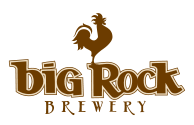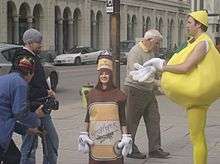Big Rock Brewery
 | |
| Traded as | TSX: BR |
|---|---|
| Industry | Alcoholic beverage |
| Founded | 1985 |
| Founder | Ed McNally |
| Headquarters | Calgary, Alberta, Canada |
Key people | Robert Sartor (Chief Executive Officer) [1] |
| Products | Beer |
Production output |
|
| Revenue |
|
| |
| |
| Owner | Public |
| Website |
www |
Big Rock Brewery is a Canadian public company with offices and a brewery located in Calgary, Alberta, Canada.[3] Big Rock distributes its products in Alberta and several other Canadian provinces.
History
The brewery was founded in 1985 by Ed McNally.
A lawyer by trade, McNally was representing a group of barley growers in a legal action against the Alberta Wheat Board in the 1980s. Through the course of the legal action, McNally learned that the Alberta climate produces 2-row barley that is ideally suited for malting, and had access to glacial water from the nearby Rocky Mountains.
At the time, most barley production in Alberta was used as cattle feed. With an entrepreneurial background, McNally decided to open a craft brewery. The name "Big Rock" was chosen from a large glacial rock located outside of the town of Okotoks, 18 km (11 mi) south of Calgary.
The first brewmaster was Bernd "Peppy" Pieper, a German brewmaster for Heineken International. In the summer of 1986, when Big Rock had been in production for only a year, there was a strike at the Molson and Labatt, the two largest domestic breweries. This proved to be a windfall for Big Rock, as it was the only beer available in Alberta that summer. The brewery operated around the clock to meet demand for the entire summer, and sales doubled.
The second brewmaster was Larry Kerwin, a former brewmaster for Molson. Kerwin started as a brewer at Big Rock under Pieper in 1994, and took over as brewmaster in 1998 when Pieper retired.
The third (and current) brewmaster is Paul Gautreau. Gautreau joined Big Rock in 1986 as its fourth employee, and worked in marketing and operational capacities before replacing Kerwin as brewmaster.
In 2008 Big Rock Brewery had 520 employees and 54 million CAD market capitalization.[4]
Ed McNally, who was made a member of the Order of Canada and awarded the Alberta Centennial Medal in 2005, later retired from day-to-day operation of the company, retaining the ceremonial title "Chairman Emeritus" until his death in August 2014.[5]
In order to serve the growing market in the province of British Columbia, a new brewery was built in Vancouver, and is expected to start production in 2015.
Products
Premium beers
- 'Traditional' - Commonly referred to as “'Trad'”, this is a medium-bodied brown ale in the traditional English style. It has a sweet, caramel malt flavour with a slight nutty bite.
- 'River Valley' - Golden Lager that is batch brewed.
- 'Grasshopper' - A medium-full bodied Kristall Weizen (filtered wheat ale) with notes of citrus and vanilla. Winner of the 2007 and 2009 Gold Medal "Wheat Beer" at the Canadian Brewing Awards and named "Best Patio Beer" by the National Post in 2006.
- 'Big Rock Lime' - The beer was introduced in the summer of 2008, shortly after the introduction of Bud Light Lime showed the "lime beer" market to be attractive. This is a light-tasting lager infused with a natural lime flavor.
- 'Jack Rabbit' - Marketed as "low-carb", it contains 3.8% ABV, and about 90 calories. The flavor profile is consistent with other light beers.
- 'Pale Ale' - Pale Ale was released in 1986, and is a traditional pale ale that is dry hopped to provide a hop aroma. Tart hop flavours, notes of citrus and herbs. The most bitter of Big Rock brands, although not so bitter as an India Pale Ale.
- 'Warthog Ale' - A brown ale with an amber colour and balanced toffee-caramel malt and hop flavour.
- 'Honey Brown Lager' - A medium-brown lager with Alberta-grown clover honey added for flavoring.
- 'McNally's Extra Strong Ale' - A strong Irish Ale with sweet, complex flavours reminiscent of Scotch whisky.
- 'Black Amber' - A stout that's dark and rich like both coffee and chocolate. An Alberta-inspired stout.
- 'McNally's Reserve' - A more traditional stout, served only on draught.
- 'Gopher Lager' - Introduced in the summer of 2010. A light-colored lager beer with an aftertaste provided by Saaz hops.
- 'Rock Creek Dry Cider' - Made with Okanagan-grown cider apples, with notes of vanilla and cinnamon.
- 'Magpie Rye Ale' - A copper-colored Ale made with a mixture of pale and Rye malts. Discontinued in 1995, but reintroduced in 2010.
- 'India Pale Ale' - Introduced in spring 2011, this beer is a more bitter version of the Pale Ale.
Value Beers
Alberta Genuine Draft, Bow Valley Lager, are inexpensive beers brewed for their alcohol content.
Cider
- 'Rock Creek Dry Cider' - A dry cider made from Okanagan apples and pears.
- 'Rock Creek Cranberry Cider' - A dry cider with a cranberry twist
Contract brews
Big Rock brews beers for restaurants in Western Canada, including:
- Moxie's Big Life Beers, which consist of a Euro-style lager, and an amber ale.
- Hudsons Tap House Beers, which include Beaver Tail Amber Ale, and Lumberjack Premium Lager.
- John Palliser Ale for the Fairmont Palliser Hotel in Calgary, Alberta.
- Livingston Lager for Heritage Park in Calgary, Alberta.
- Bucktooth Brew Amber Ale for Joe Beeverz Bar & Grill in Brandon, Manitoba and Yorkton, Saskatchewan.
- DockHouse Light Lager for The Dock on Princess in Brandon, Manitoba.[6]
Big Rocks brews the President's Choice beers (PC Dry, PC Honey Red, PC Pilsener, and PC Light) for Loblaw Companies Limited in their western Canadian markets (The Real Canadian Liquorstore)
Seasonal brews
- 'Espresso Stout' - A dark stout ale released in the Christmas season. The brew is not available on tap, and comes in a six-pack box containing four bottles of beer, two commemorative glasses, and a bag of chocolate covered espresso beans.
- 'Maibock' - A bock-styled beer released in May 2005 for the Big Rock 20th anniversary.
Discontinued brews
- 'Big Rock Bitter' - Introduced in 1985 and discontinued in 1987.
- 'Big Rock Porter' - Introduced in 1985, and discontinued in 1987.
- 'Cold Rock Winter Porter' - Introduced for the Calgary 1988 Olympic Winter Games, and discontinued the following year.
- 'Kold Lager' - A light lager, and Big Rock's first attempt at brewing a lager. This new style met with resistance from the craft beer community who preferred the more flavourful ales, but did help Big Rock achieve more mainstream popularity with drinkers of "macrobrews". Discontinued in 2005.
- 'India Pale Ale' - An India Pale Ale, but was not sufficiently differentiated from the Pale Ale. Retired in 2005, but reintroduced in 2011.
- 'Royal Coachman Light Dry Ale' - *'Chinook Pale Ale'
- 'Magpie Rye Ale' (discontinued in 1995, but reintroduced in 2010.)
- 'Canvasback'
- 'XO Lager' - Introduced in 2007, and replaced Kold Lager brand. Floral aroma, white head and smooth taste defined by a Czech hoppiness. The beer had a flavour profile similar to more mainstream "macrobrews". Now discontinued, replaced by Gopher lager.
- 'Bow Valley Strong' - discontinued in 2017.
Marketing

In 1993, the Big Rock Brewery started "The Big Rock Eddies", a promotional contest to encourage beer drinkers to make the advertisements for Big Rock. The contest later included a Student category that allows post-secondary students to compete with their peers for prize money. The red carpet events, many organized by Calgary's Event Group,[7] have grown from one event in Calgary Alberta, to four events across Canada: Calgary, Edmonton, Vancouver and Toronto.
See also
References
- ↑ "Company Snapshot Big Rock Brewery Inc.". Infomart. Retrieved 19 July 2012.
- 1 2 3 4 "Big Rock Brewery Inc. announces 2015 financial results and date of annual meeting" (PDF). Retrieved 2 May 2016.
- ↑ "History of Big Rock". Big Rock Brewery. Retrieved 19 July 2012.
- ↑ "Company Profile for Big Rock Brewery Income Trust (CA;BR.UN)". Retrieved 2008-10-10.
- ↑ "Big Rock Brewery Inc. Announces Passing of Founder". Marketwire. Aug 20, 2014.
- ↑ "Broadening beer horizons". Brandon Sun. May 4, 2015. Retrieved February 15, 2017. (subscription required)
- ↑ Robert E. Hoskin; Maureen R. Fizzell; Ronald A. Davidson (9 January 2002). Financial Accounting: A User Perspective. John Wiley & Sons. p. 741. ISBN 978-0-471-64372-2.
External links
Coordinates: 50°59′05″N 113°57′16″W / 50.9847°N 113.9544°W